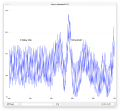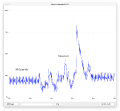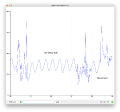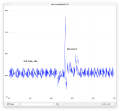| (9 intermediate revisions by the same user not shown) | |||
| Line 11: | Line 11: | ||
== Awareness and Movement and the Phonetic Garden == | |||
FOR THE FINAL DOCUMENTATION OF THIS WORK - VISIT: | |||
https://www.uni-weimar.de/kunst-und-gestaltung/wiki/Cosmo_Schueppel | |||
''The state of the reaserch as of June 1st'' | |||
''As a participatory sound installation the piece aims to create a space for inter special communication between humans and plants - a space to become aware of your effect on the world around and a space to mindfully experience your movement.'' | |||
{{#ev:vimeo|716195918}} | |||
Awareness and Movement in a Phonetic Garden, a movement-meditation-interface of the Technocene opens questions of humankind’s relation with the world around them. In the human centred thinking of the Anthropocene it is often overlooked that our behaviour has an effect on our surrounding - as blatantly obvious as it is. This lack of awareness about the consequences of our action is affecting all living beings, in nature and in our society, in negative ways. It is time to overcome this lack of empathy to move into a new future. | |||
The installation consists of a dimly lit space, with plants spread around. Every plant is connected to a self build device which measures changes in electric fields (EFs). EFs always surround us and are omni present. From my research and my experiments arose the observation that human movement can be detected through changes in EFs. Taking into account that plants and fungi communicate with electric signals, it can be assumed that plants can sense their surroundings through these changes in the electric fields. This thesis is, of course, still highly speculative and needs further experimentation. Consequently, the work does not aim to show these experimental observations. Instead, it tries to use the current state of this research to create a feedback loop, a mutual influence, a form of communication between human and plant. A communication, a connection which is supposed to result in a higher sensitivity in experiencing our surroundings. The work tries to make it possible, that we humans can experience our impact on the world around us, imminent and translated into a language that we can understand: Sound. | |||
The | The sonification is accomplished as follows: The electric fields are measured with a self-build devise using an Arduino mini-computer. The EF data, measured in a relative manner in bits, is transcribed into sonic frequencies. (0-1023 bit = 100-3000Hz). | ||
There are two options for the sonification of the EF data. The frequencies transcribed from the electric field data, will either be altered digitally or in an analog way. Using either a software to change the sound or self build corpuses and resonance bodies. The experimentations to find the best solution are still a work in progress. | |||
<gallery> | |||
File:Screenshot 2022-06-01 at 20.03.25.png|Max Patch | |||
File:Screenshot 2022-06-01 at 20.27.30.png|400px|Arduino Code | |||
File:Screenshot 2022-06-01 at 19.59.54.png|400px|0 Delay Example | |||
File:Screenshot 2022-06-01 at 19.55.46.png|400px|50 Delay Example | |||
File:Screenshot 2022-06-01 at 19.55.00.png|400px|100 Delay Example | |||
File:Screenshot 2022-06-01 at 19.59.24.png|400px|350 Delay Example | |||
</gallery> | |||
''''' | '''''References''''' | ||
Plants sensing human presents | |||
[[:File:1597645969Recognizing Individuals and Their Emotions Using Plants as Bio-Sensors through Electro-static Discharge.pdf]] | |||
Plants sensing electric fields | |||
https://www.sciencedaily.com/releases/2016/07/160708082037.htm | |||
Electric Signals in Plants | |||
https://www.frontiersin.org/articles/10.3389/fpls.2017.02173/full | |||
[[:File:Davies_2006_bookchapter-2.pdf]] | |||
| Line 84: | Line 82: | ||
'''The state of the reaserch as of May 5th | |||
'''History''' | |||
''The state of the reaserch as of May 5th'' | |||
*[[220505sketch]] | *[[220505sketch]] | ||
''The state of the reaserch as of April 28th'' | |||
*[[220428sketch]] | *[[220428sketch]] | ||
Latest revision as of 13:53, 17 August 2022
Home Made Bioelectronics
Project Research
Cosmo Niklas Schüppel
Awareness and Movement and the Phonetic Garden
FOR THE FINAL DOCUMENTATION OF THIS WORK - VISIT:
https://www.uni-weimar.de/kunst-und-gestaltung/wiki/Cosmo_Schueppel
The state of the reaserch as of June 1st
As a participatory sound installation the piece aims to create a space for inter special communication between humans and plants - a space to become aware of your effect on the world around and a space to mindfully experience your movement.
Awareness and Movement in a Phonetic Garden, a movement-meditation-interface of the Technocene opens questions of humankind’s relation with the world around them. In the human centred thinking of the Anthropocene it is often overlooked that our behaviour has an effect on our surrounding - as blatantly obvious as it is. This lack of awareness about the consequences of our action is affecting all living beings, in nature and in our society, in negative ways. It is time to overcome this lack of empathy to move into a new future.
The installation consists of a dimly lit space, with plants spread around. Every plant is connected to a self build device which measures changes in electric fields (EFs). EFs always surround us and are omni present. From my research and my experiments arose the observation that human movement can be detected through changes in EFs. Taking into account that plants and fungi communicate with electric signals, it can be assumed that plants can sense their surroundings through these changes in the electric fields. This thesis is, of course, still highly speculative and needs further experimentation. Consequently, the work does not aim to show these experimental observations. Instead, it tries to use the current state of this research to create a feedback loop, a mutual influence, a form of communication between human and plant. A communication, a connection which is supposed to result in a higher sensitivity in experiencing our surroundings. The work tries to make it possible, that we humans can experience our impact on the world around us, imminent and translated into a language that we can understand: Sound.
The sonification is accomplished as follows: The electric fields are measured with a self-build devise using an Arduino mini-computer. The EF data, measured in a relative manner in bits, is transcribed into sonic frequencies. (0-1023 bit = 100-3000Hz). There are two options for the sonification of the EF data. The frequencies transcribed from the electric field data, will either be altered digitally or in an analog way. Using either a software to change the sound or self build corpuses and resonance bodies. The experimentations to find the best solution are still a work in progress.
References
Plants sensing human presents
Plants sensing electric fields
https://www.sciencedaily.com/releases/2016/07/160708082037.htm
Electric Signals in Plants
https://www.frontiersin.org/articles/10.3389/fpls.2017.02173/full
File:Davies_2006_bookchapter-2.pdf
Using Trees to send Radio Frequencies
https://we-make-money-not-art.com/tree_antenna/
EMF Detection on Arduino
https://www.instructables.com/Arduino-EMF-Detector/
History
The state of the reaserch as of May 5th
The state of the reaserch as of April 28th





